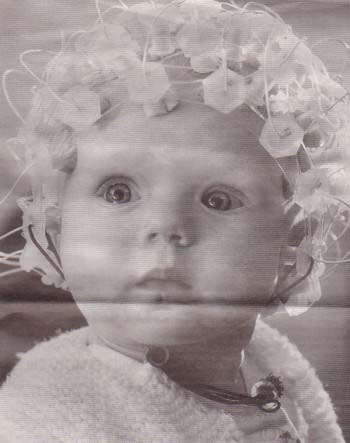I A "Woman's Page"in the Guardian 9.7.02
Welcome to the baby lab: with an advt. at the end of article (If you have a a baby, or are expecting one, and live within easy travelling distance of London,and would like to volunteer for a Babylab Study, call Jane on 020-7631 6258.Expenses are reimbursed)! ! !
"Catriona is only 5 months old but already she has her first accolade - an infant science degree awarded at Birbeck College, London, England,for her outstanding contribution to developmental psychology.  Catriona became one of hundreds of infants who take part in experiments into how, and what, babes think. ....Only one infant is in the lab at a time and there are four adults talking to her....When they (the infants) are least expecting it the net goes on. Apparently a minority of babies refuse point-blank to have anything to do with it but Catriona is in the majority....Her head is now enmeshed in what is known in the trade as a geodesic hairnet. Next it 's on to the experiment which takes place in a darkened cubicle..Again it is fun,fun,fun, with the hairnet now plugged into a computer so that its foamcovered electrodes can record Catriona's brainwaves and there is a video recording her reactions to what she can see... a series of cartoons interspersed with up-side down faces appear on screen. It all adds up to the best morning Catriona has ever had (sic)...and it really helps the research, the reading of her brainwaves will be analysed along with those of other young subjects TO SEE HOW THE UP-SIDE DOWN FACE IS PROCESSED by the infant mind. The research is being used as a control to a recent experiment - results indicate babies look longer at faces they can make eye-contact with,says Dr.Teresa Farroni. Infant-brain research ( it is only during the last 20 years or so that scientists have been doing this research) and among them ..it has a great and highly significant future. "The broader field of cognitive neuroscience really is THE exciting project of the last 10 years in scientific research ! !" says Dr Denise Mareschal. In reference....to correcting the development of a condition (not behaving normally precedes a list, autism etc.) ..a baby's brain is uniquely plastic..malleable...adaptable. Neurologists are watching these experiment closely...Once the plasticity of infant brains is understood it is possible this knowledge could PROVIDE IDEAS ....(this research is also linked to market forces - toys for "ambitious" parents)
Brain-Monitors May Soon Scan
Travelers' Minds At Airports
By Frank J. Murray
The Washington Times
8-17-2
- Airport security screeners may soon try to read the minds of travelers to identify terrorists. Top Stories
- Officials of the National Aeronautics and Space Administration have told Northwest Airlines security specialists that the agency is developing brain-monitoring devices in cooperation with a commercial firm, which it did not identify.
- Space technology(!) would be adapted to receive and analyze brain-wave and heartbeat patterns, then feed that data into computerized programs "to detect passengers who potentially might pose a threat," according to briefing documents obtained by The Washington Times.
- NASA wants to use "noninvasive neuro-electric sensors," imbedded in gates, to collect tiny electric signals that all brains and hearts transmit. Computers would apply statistical algorithms to correlate physiologic patterns with computerized data on travel routines, criminal background and credit information from "hundreds to thousands of data sources," NASA documents say.
- The notion has raised privacy concerns. Mihir Kshirsagar of the Electronic Privacy Information Center says such technology would only add to airport-security chaos. "A lot of people's fear of flying would send those meters off the chart. Are they going to pull all those people aside?"
- NASA aerospace research manager Herb Schlickenmaier told The Times the test proposal to Northwest Airlines is one of four airline-security projects the agency is developing. It's too soon to know whether any of it is working, he says.
- "There are baby steps for us to walk through before we can make any pronouncements," says Mr. Schlickenmaier, the Washington official overseeing scientists who briefed Northwest Airlines on the plan. He likened the proposal to a super lie detector that would also measure pulse rate, body temperature, eye-flicker rate and other biometric aspects sensed remotely.
- Though adding mind reading to screening remains theoretical, Mr. Schlickenmaier says, he confirms that NASA has a goal of measuring brain waves and heartbeat rates of airline passengers as they pass screening machines.
- This has raised concerns that using noninvasive procedures is merely a first step. Private researchers say reliable EEG brain waves are usually measurable only by machines whose sensors touch the head, sometimes in a "thinking cap" device. "To say I can take that cap off and put sensors in a doorjamb, and as the passenger starts walking through [to allow me to say] that they are a threat or not, is at this point a future application," Mr. Schlickenmaier said in an interview.
- "Can I build a sensor that can move off of the head and still detect the EEG?" asks Mr. Schlickenmaier, who led NASA's development of airborne wind-shear detectors 20 years ago. "If I can do that, and I don't know that right now, can I package it and [then] say we can do this, or no we can't? We are going to look at this question. Can this be done? Is the physics possible?"
| |

